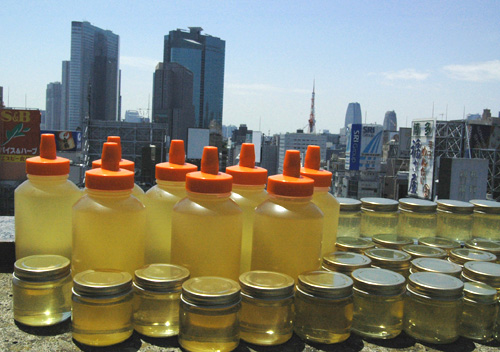
from Japan vol. 54 2010.10.31 A metropolitan Satoyama tale spun by honey bees of Ginza
![]()
Honey bees flying busily from flower to flower, the ears of rice in the paddy fields swaying in the wind - common scenery one may come across in the countryside. You may be surprised to hear, however, that this actually describes a view of a building rooftop in the glamorous, bustling city of Ginza, Tokyo. Many of you may have heard that honey can be harvest in Ginza. Ever since the ‘Ginza Honey Bee Project’ was launched in 2006, this city has been working to transform itself into a "Satoyama that brings people closer together." Promoting rooftop gardens to create habitats for honey bees or having well-established stores use the honey harvested in Ginza for cakes and cocktails, thereby realizing ‘local production for local consumption’ - as though reeled in by the bees, many people are coming together and giving way to new and inventive ideas. By following the bees, Ginza, which had been searching for the answer to sustainable development, seems to have unexpectedly stumbled upon the key to "coexisting with nature." We went to Ginza to take a look at the changes "honey bees have wrought." (Title photo:The Ginza Honey Bee Project)
Back to Table of Contents Meeting the honey bees
It was a hot summer day in early September when we visited the Ginza Pulp and Paper Hall located in Ginza 3-chome. Honey bees inhabit the rooftop of this 11-story building. The hive boxes are home to both Western and Japanese honey bees. Millions of them fly around everyday collecting nectar from trees and plants all around Ginza.
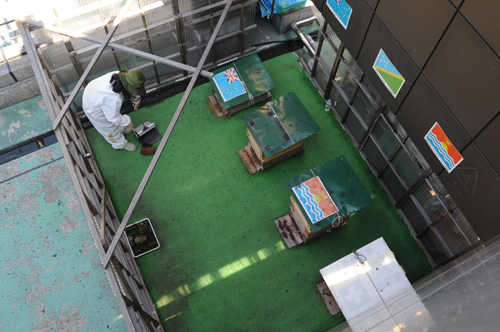 Honey bees' homes - 4 hive boxes for Western honey bees. The hive boxes of Japanese honey bees are elsewhere.
Honey bees' homes - 4 hive boxes for Western honey bees. The hive boxes of Japanese honey bees are elsewhere.
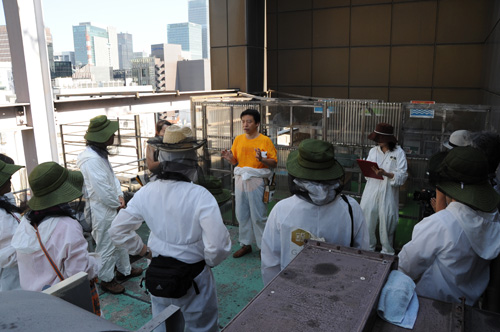 On this particular day, a seminar for those interested in creating gardens for honey bees was being held. There are hives behind the fencing. In the center stands Mr. Tanaka, co-founder of the 'Ginza Honey Bee Project'.
On this particular day, a seminar for those interested in creating gardens for honey bees was being held. There are hives behind the fencing. In the center stands Mr. Tanaka, co-founder of the 'Ginza Honey Bee Project'.
On the day of our visit, preparations to cope with the change in seasons - from fall to winter - were being made and honey was also being harvested. We were all set to go once we wore white, protective clothing and a hat with a net over our heads. I was a little hesitant going near the buzzing bees at first, but once you get close, you see that there is no reason to be afraid. It was like you were sharing the same space with the bees.
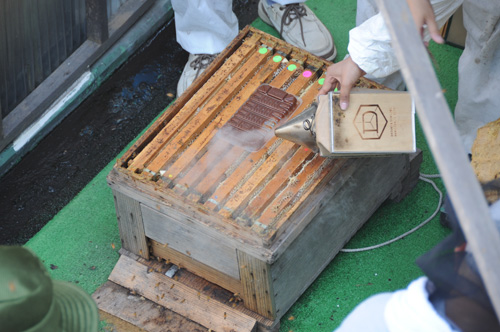 You burn the newspaper with the smoker to produce smoke. It is said that smoke calms the bees down.
You burn the newspaper with the smoker to produce smoke. It is said that smoke calms the bees down.
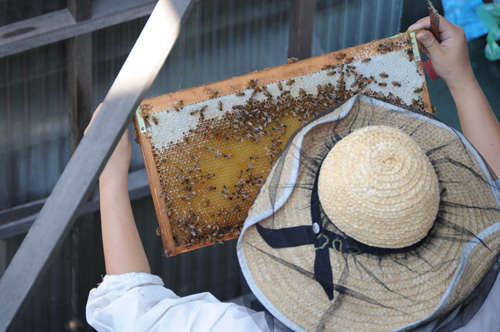 Checking on the bees. In principle, the work is carried out barehanded.
Checking on the bees. In principle, the work is carried out barehanded.
The work is done barehanded. This is because when you wear gloves, you begin to handle the hives more brusquely and heavy-handedly, and this agitates the bees. The metropolis is full of people, so beekeeping in the city requires special consideration. Calming down the bees with smoke is one such consideration. When you get used to it, you will be okay even if you had a bee sitting on the palm of your hand.
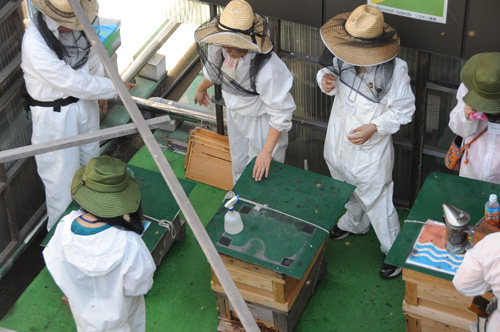 We entered the partitioned area and our work finally began.
We entered the partitioned area and our work finally began.
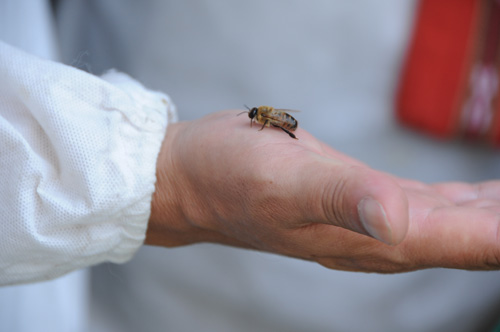 When you get used to it, you will not be disconcerted even if you had a bee sitting on the palm of your hand. Bees maintain a body temperature of around 34 degrees Celsius, so they feel warm to the touch.
When you get used to it, you will not be disconcerted even if you had a bee sitting on the palm of your hand. Bees maintain a body temperature of around 34 degrees Celsius, so they feel warm to the touch.
This is how you harvest the honey. You move the bees from the hives, and shave off the bees wax attached to the hive frame (bees wax can be used to create candles). Then, you load the uncapped frame into the honey extractor, which uses centrifugal force to extract the honey from the frame. Next, you filter the honey to separate it from the bits of wax. Although it was already past the peak honey harvest season, we were able to collect approximately 10kg of honey in one day. Because nectar is available in Ginza during the summer time as well, some honey can be harvested even in September. When I tasted the honey before it was placed into the honey extractor, it had a mild, gentle flavor.
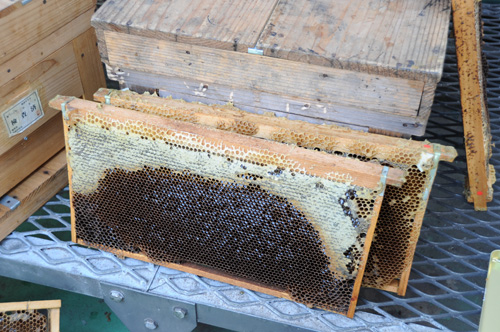 The frames after the bees have been moved.
The frames after the bees have been moved.
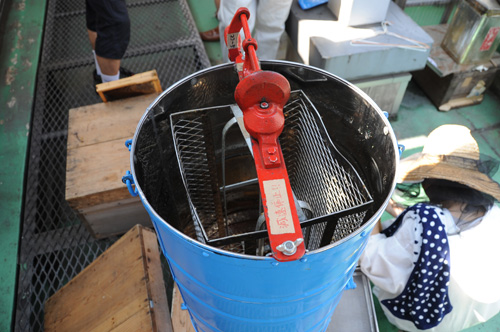 You place the frames into the honey extractor and run it to harvest the honey.
You place the frames into the honey extractor and run it to harvest the honey.
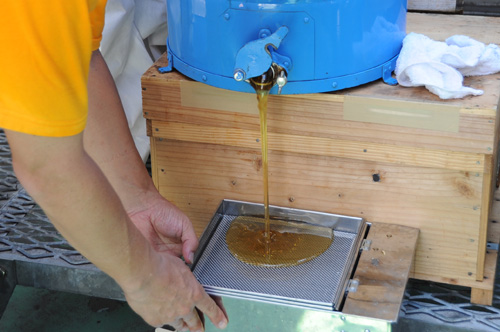 A fresh batch of honey.
A fresh batch of honey.
Back to Table of Contents
It began with a playful idea
The honey bee project in Ginza began in 2006. It started when Mr. Atsuo Tanaka, the Managing Director of the Paper and Pulp Hall, which rents out conference rooms, and Mr. Kazuo Takayasu from Agricreate, who is in the organic vegetable distribution business, met a beekeeper. When Mr. Tanaka learned that Mr. Seita Fujiwara, a beekeeper in Iwate prefecture, was looking for a location for apiculture in Ginza, he told him that he could use the rooftop of the Paper and Pulp Hall building. But Mr. Fujiwara replied, "There's not enough space up there to run a business. I'll teach you how to do it, so why don't you give it a go."
Mr. Tanaka and Mr. Takayasu were startled at first, but thought, "It would be interesting if there were honey bees in Ginza" so they decided to give it a try. Mr. Fujiwara has had experience beekeeping on rooftops as he already had bees on the roof of the Social Democratic Party building in Nagatacho, Tokyo. "I had seen tulip trees near the Imperial Palace, so I knew that the honey from this area would be the best quality" states Mr. Fujiwara with confidence.
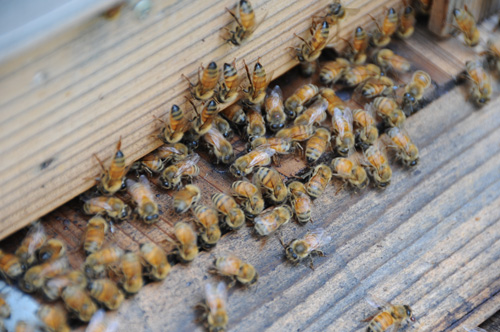 There are many trees and other vegetation in Ginza even in the summer time, so there is plenty of nectar.
There are many trees and other vegetation in Ginza even in the summer time, so there is plenty of nectar.
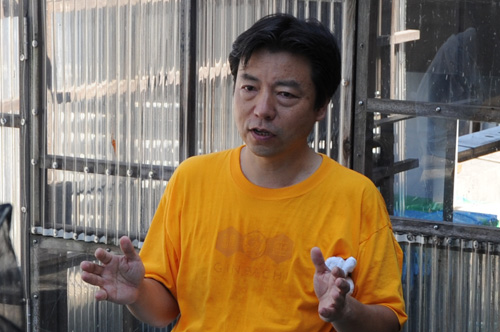 Mr. Atsuo Tanaka, co-founder of the incorporated NPO Ginza Mitsubachi (Honey Bee) Project.
Mr. Atsuo Tanaka, co-founder of the incorporated NPO Ginza Mitsubachi (Honey Bee) Project.
"Keeping honey bees in Ginza - people must have though we were quite avant-garde" laughs Mr. Tanaka. But he believes that this has been possible because of the open-mindedness of the people of Ginza. Of course before they began their activities, they consulted many people in the town and also got the approval of all the tenants in the building, but some people were concerned that the bees may sting people. Having said that, there were many people who were sympathetic to this playful idea.
Back to Table of Contents Urban development from honey bees' perspective
The harvest from honey bees in Ginza the first year was 150kg. In 2007, it rose to 290kg, in 2008 to 440kg, and as of July this year, as it was the case last year, the harvest has surpassed 800kg. And the project now has 135 supporting members.
If you look at other parts of the world, beekeeping in the city is not rare. In Paris, apiculture had already begun years ago. Honey harvested on the rooftops of the Opera House and the Grand Palais, which was the venue for the world exposition held in 1900, has become a specialty of Paris. On the streets you will find acacia and lime trees, and there are a wide range of potted plants in the apartment balconies. The Tuileries Garden is located nearby as well, so Paris is an optimal environment for honey bees. And because there are many different types of flowers, you can enjoy a variety of flavors.
In March this year, New York uplifted the ban on beekeeping within the city boundaries. In London, too, beekeeping seminars for citizens are becoming quite popular. Honey bees and the city environment fit very well together. Ginza, with rich sources of nectar nearby such as in the Imperial Palace, Hibiya Park, and Hamanorikyu must be a very comfortable environment for honey bees.
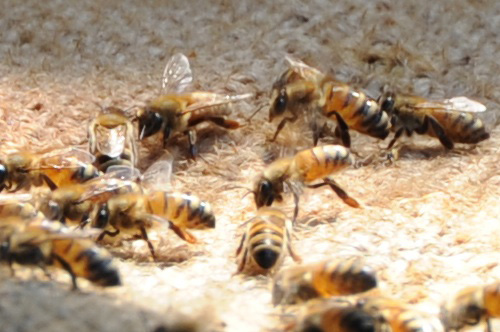 For honey bees perhaps cities are more comfortable to live in than the countryside.
For honey bees perhaps cities are more comfortable to live in than the countryside.
Mr. Hideo Watanabe, the advisor to APIMONDIA (International Federation of Beekeepers' Associations), who has kept bees at his home in Setagaya for 30 years now says, "Honey bees will save cities." Honey bees need greenery to survive, and they are very vulnerable against pesticides. They are especially susceptible to neonicotinoid insecticides, and this is believed to be a cause of death en masse. In the countryside, a lot of pesticides are used to farm effectively, and many trees that do not bloom such as cedars and cypress have been planted, so sources of nectar have become depleted. This has created a harsh environment for honey bees to live in. When thinking about the future of the global environment, it is important to create an environment that honey bees can inhabit.
Mr. Watanabe believes that honey bees have 4 roles.
First role is in "health and lifestyle." They provide honey, propolis, and royal jelly, which are great for our health.
Second, "pollination." They carry pollen from flower to flower, so they perform a key role in pollination and in helping plants bear rich fruit.
Thirdly, they help "improve the environment." Honey bees need good air and water. An environment that is comfortable for honey bees is an environment that is also good for human beings.
Last but not least, they help "improve our society." They bring people together as pollinators, and teach us how important it is to live in harmony with nature and to work as one.
Mr. Tanaka also says that the way he "perceived" the city changed since he has started beekeeping. Nearby trees get pollinated, bear fruit, and birds come to eat the fruit - touched by nature's blessing, he began to take action to create a city that is comfortable for small animals to live in as well. He decided to become a pollinator himself and began 2 projects, the "Bee Garden Project" and the "Farm Aid Project" to bring people closer together.
Back to Table of Contents The spread of 'bee gardens'
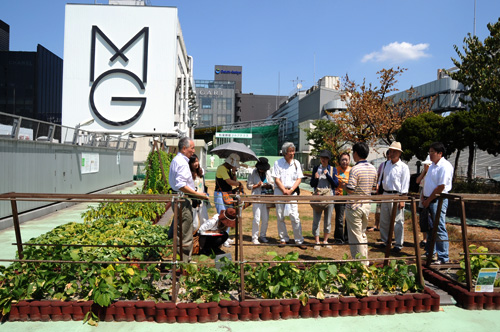 The bee garden on top of Matsuya Ginza, one of the first organizations to begin rooftop gardening. It is a shame that the greenery has welted due to the summer heat.
The bee garden on top of Matsuya Ginza, one of the first organizations to begin rooftop gardening. It is a shame that the greenery has welted due to the summer heat.
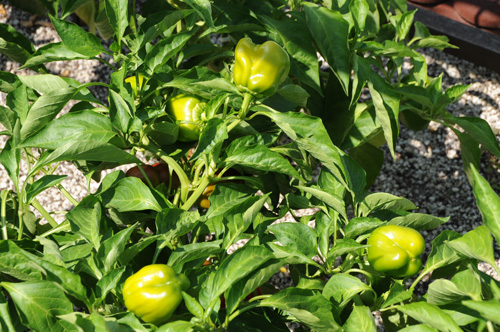 On the rooftop of Matsuya, you can see vegetables such as tomatoes, goya (bitter gourd), and green peppers growing. This year Matsuya also harvested "Kurosaki Chamame," a type of soybeans from Kurosaki, Niigata.
On the rooftop of Matsuya, you can see vegetables such as tomatoes, goya (bitter gourd), and green peppers growing. This year Matsuya also harvested "Kurosaki Chamame," a type of soybeans from Kurosaki, Niigata.
The "Bee Garden Project" calls on people to increase greenery in Tokyo, so that honey bees can live comfortably. Many such as Matsuya Ginza, Ginza Blossom, and Marronnier Gate have answered this call, and there are now more than 1,000 square meters of small farms and gardens on the rooftops of these buildings. Mitsukoshi, which has just recently opened for business after renovation, has its balconies lined with grass and small farms on its rooftops.
An especially brilliant rooftop garden is the one on the Hakutsuru Hall building. Here, they grow rice for brewing Japanese sake. The view of the "rice paddies" that spreads before you when you open the door to the roof is a sight to see. You almost forget that you are in the city when you see the ears of golden rice swaying in the wind. Of course it is probably not as magnificent as the rice fields in the countryside, but you still get to see sparrows, dragonflies, and various other insects. There are also cherry blossom trees planted on the roof, so honey bees from the Paper and Pulp Hall rooftop fly over as well. Where there is greenery, there is animal life - you can really sense that this is the case.
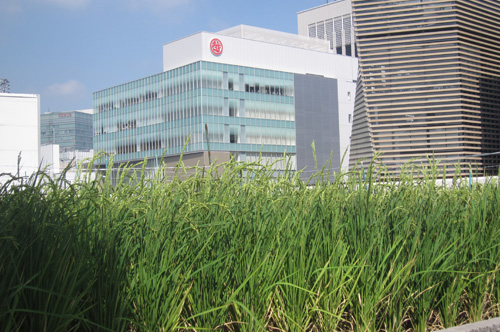 When you open the door to the rooftop of the Hakutsuru Hall building, a field of rice spreads before you. Here, they grow rice for brewing sake, which has been independently developed. (photo:Atsuko Koizumi)
When you open the door to the rooftop of the Hakutsuru Hall building, a field of rice spreads before you. Here, they grow rice for brewing sake, which has been independently developed. (photo:Atsuko Koizumi)
It was in 2007 that Hakutsuru Sake Brewing Co., Ltd., whose headquarters are located in Kobe, Hyogo prefecture, began making sake in Ginza. In 2008 they harvested a little under 15kg of rice from 70 square meters. Last year, they harvest 45kg of rice. You can taste the sake created from the rice harvested in the tasting seminar held in the same building. They also help children in the local elementary school grow Koshihikari variety of rice on the rooftop, which will be harvest in October. Tours to farms in the countryside that provide agricultural experience have become quite popular, but it is great that you can now get a taste of it quite nearby.
The consumption of sake is on the decrease, so the initial thought was to promote sake using the strength of the "Ginza" brand. But it had a much bigger effect than first expected. During harvest time, various groups of people from the Ginza Honey Bee Project staff to mama-sans (female proprietor) of hostess clubs and bartenders come to help. You could say, that the bees have performed one of their roles and brought people together as pollinators. Mama-sans, who fell in love with the fields of rice in the middle of Ginza, have even started a "greening club." And their dreams - growing ginger and herbs in the farms and serving them to their customers - continue to grow.
Mr. Asami Oda, the director and person in charge of the farm at Hakutsuru would like to start growing wheat as the second crop of the year after the rice is harvested (they harvested 7kg of wheat last year). He says, "It would be fun to be able to make something with the wheat and honey harvested in Ginza. I am constantly thinking of things we could do through our rooftop. The fields have created opportunities for people to meet each other, and I feel that it is now a precious part of my life." This feeling pushes him forward to do more.
Having said that, caring for the bees and growing rice does not happen overnight. You cannot stop caring for them because it is the weekend, so these efforts require considerable time and effort, patience, and resolve. Many cities all over Japan are embarking on beekeeping, but Mr. Tanaka from the Ginza Honey Bee Project says that what is important is perseverance. He has heard of some cases where people begin, but give up after a while.
The reason why the Ginza project has been successful is that there was strong volition to get the entire city involved. Mr. Tanaka and Mr. Takayasu has been involved in discussions about what Ginza's should be about and about its future before they began the project, and I realized as I was doing the footwork and writing this report that a big movement has occurred because they cherished the ties between people. "If your desired end product is honey, it is difficult to keep it going. The honey harvest is not consistent. Sometimes you get some, sometimes you don't. If there is no nectar, we have to work together to plant flowers. It is difficult for the project to take root if we don't think about how the honey bees are accepted by the community, and how we can help these small creatures flourish." (Mr. Tanaka)
Back to Table of Contents A project that brings farmers and cities together
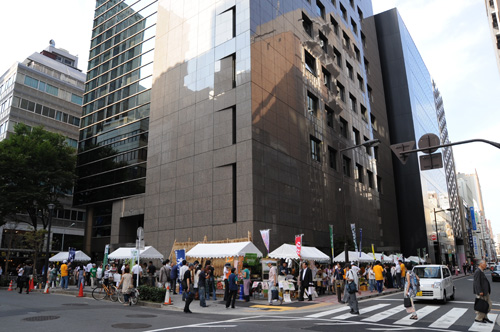 Crowds of people from the city gather in front of the Paper Pulp Hall on the day of the Farm Aid event.
Crowds of people from the city gather in front of the Paper Pulp Hall on the day of the Farm Aid event.
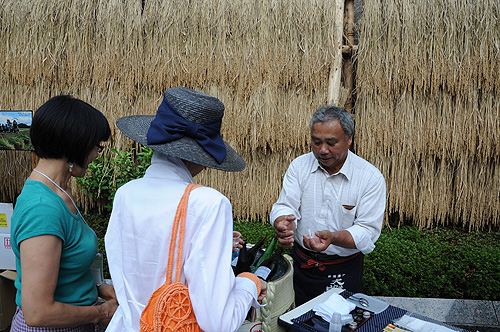 Straws from the rice harvested in the Niigata brewery were hung at the Farm Aid event held in September. Pictured in the photograph is master brewer, Mr. Masaru Tazawa.
Straws from the rice harvested in the Niigata brewery were hung at the Farm Aid event held in September. Pictured in the photograph is master brewer, Mr. Masaru Tazawa.
"Farm Aid Ginza" is the second type of activity that was launched in 2008. Keeping in mind the idea, "Sustainable Network Festa that brings together forests, villages, cities, and the sea," events that unite the city and farmers and producers in the rural area are held regularly. In the September edition of Farm Aid, we were able to see hanging straws from the brewery in Niigata. This is known as "Hasagake," a process of slowly drying the stalks of harvested rice under the sun. Mr. Tanaka happily explained that unexpected opportunities arise one after another.
The honey harvested in Ginza has been commercialized in various ways, but what they tried to always keep in mind was "local production for local consumption." They wanted craftsmen in Ginza to use the honey to create products that could be sold in Ginza. This wish has come true turning into macaroons offered at Hotel Seiyo Ginza, honey infused castellas at Bunmeido, and cocktails in Mikasa Hall's bar 5517. Swan, a social welfare service, sells rusks at a bakery where mentally challenged people work. An association of bars and clubs, the "Ginza Shako Inryou Kyoukai (Ginza Society Food and Beverage Association)" created an original cocktail, the "Honey Highball," to commemorate its 85th anniversary. A small portion of the proceeds from these cocktails will be donated to greening efforts in Ginza.
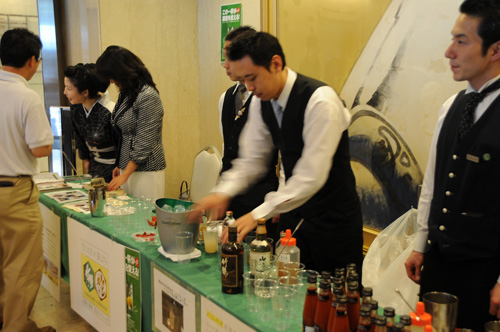 Club bartenders and mama-sans proudly served "Honey Highballs" at the Farm Aid event. Many people stopped by to get a taste of the cocktail.
Club bartenders and mama-sans proudly served "Honey Highballs" at the Farm Aid event. Many people stopped by to get a taste of the cocktail.
The coming of the honeybee's has given way to innumerable opportunities that cannot all be mentioned in this short passage, but one thing is certain. Honey bees have taught us that caring for small creatures has the potential to realize the dream of creating a Satoyama in an urban environment. Apiculture may even be undertaken on the rooftop of the Kabuki Theater, which is currently under renovation. I mentioned that honey is being harvested on the rooftop of the Opera House in Paris, but it may create quite a sensation if honey from the Kabuki Theater in Ginza becomes available in the marketplace, too. Some day buildings may become farms, and we may see various types of vegetables growing on the walls.
The Ginza Honey Bee Project established the agricultural production corporation, "K.K. Ginza Honey bee" this March. Until now, the project had relied on volunteers to take care of the bees, but this company has been established to help support the livelihoods of beekeepers and to expand production. The company has begun to cultivate potatoes on borrowed abandoned farmland in Fukushima prefecture. Mr. Tanaka, who was been inaugurated as the president of Ginza Honey Bee says that perhaps honey bees are a gateway that can lead people to rural mountain areas. So where will the Ginza honey bees head next? More and more exciting stories are sure to come.
Related URL
The Ginza Honey Bee Project http://www.gin-pachi.jp/
Atsuko Koizumi - biography
Editor and writer. Have reported on culture, IT, and education for many years, for a weekly international news magazine. Currently she edits books. She would like to communicate various global issues in a multifaceted perspectives.
Report and original Japanese text written by: Atsuko Koizumi
Translated by: Yuri Morikawa (oxygen inc.)
Edited by / photographs by: Soichi Ueda (Think the Earth Project)















